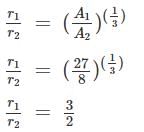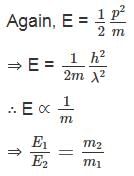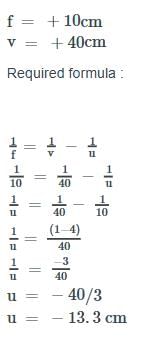Physics: CUET Mock Test - 5 - CUET MCQ
30 Questions MCQ Test CUET Mock Test Series - Physics: CUET Mock Test - 5
Calculate the value of peak reverse voltage (P.I.V.) if the full-wave rectifier has an alternating voltage of 300 V.
Emission of electron from the surface of metal when radiation of appropriate frequency is allowed to incident on it is called :
An electron, an a particle, a proton and a deutron have the same kinetic energy. Which of these particles has the shortest De Broglie wavelength.
The ratio of radii of two nuclei having atomic mass numbers 27 and 8 respectively, will be:
 years, then the amount of substance left after 12 years is :
years, then the amount of substance left after 12 years is :
Match List - I with List - II.

Choose the correct answer from the options given below :
Which of the following statement is correct?
I. Refraction is due to the change in the speed of light when it enters from one transparent medium to another.
II. The refractive index of water is 1.33.
Two particles A1 and A2 of masses m1, and m2 (m1 > m2) have the same de Broglie wavelength. Then
Consider the statements and choose the correct option.
Assertion (A): A magician during a show makes a glass lens with n = 1.47 disappear in a trough of liquid.
Reason (R): The refractive index of the liquid must be equal to 1.47 in order to make the lens disappear.
What focal length should the reading spectacles have for a person for whom the least distance of distinct vision is 50 cm?
In Young’s double-slit experiment if the distance between two slits is halved and distance between the slits and the screen is doubled, then what will be the effect on fringe width?
A lens has a focal length of 10 cm. Where the object should be placed if the image is to be 40 cm in the positive direction from the lens?
An object is to be seen through a simple microscope of power 10 D. Where should the object be placed to reduce maximum angular magnification? The least distance for distinct vision is 25 cm.
If the separation between the two slits is decreased in Young’s double-slit experiment keeping the screen position fixed, what will happen to the width of the fringe?
What is the rms value of output current if the peak value of output current is given as 0.092 A?
Find the magnification of the lens if the focal length of the lens is 10 cm and the size of the image is -30 cm.
Radioactive material decays by simultaneous emission of two particles with respective half-lives 1620 and 810 years. The time, in years, after which one-fourth of the material remains?
Why is there a sudden increase in current in Zener diode?
The communication system needed for a given signal depends on which of the following?
Identify the type of modulation where the frequency of the modulated wave is equal to that of the carrier wave.
Which of the following substances cannot be emitted by radioactive substances during their decay?
Which among the following is not easy to fabricate on an Integrated Circuit?
|
39 docs|148 tests
|






 = 1 (As we have the same de-Broglie wavelength)
= 1 (As we have the same de-Broglie wavelength)






 = 1080 year.
= 1080 year.
















